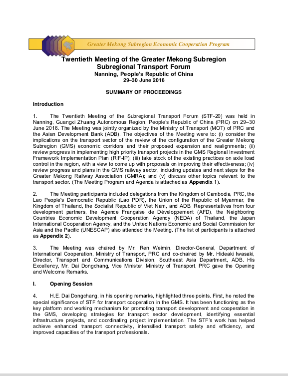All Aboard! Riding the Rails in the Greater Mekong Subregion
An ambitious effort is underway to connect the rail systems of Mekong countries so that passengers and freight can move seamlessly across borders.
Developing transport infrastructure in tandem with policies and procedures for crossing borders and promoting trade has been central to efforts to interconnect the Greater Mekong Subregion countries.
The Subregional Transport Forum reviews, coordinates and monitors regional transport plans and projects of GMS member countries.
Transport lies at the heart of Greater Mekong Subregion cooperation. The development of physical infrastructure, such as roads and bridges, in tandem with policies and procedures for crossing borders and developing trade along key routes, has been central to efforts to forge a truly interconnected subregion.
Physically connecting the countries of the subregion was one of the first initiatives of the GMS program when it was founded in 1992. The countries of the Greater Mekong Subregion have acknowledged that in order to cooperate in trade, tourism, and investment, and to realize the other benefits of the region, they must expand the road links and border crossings that connect them.
This is being done through the development of “economic corridors,” which are geographic areas, often along major highways, where a variety of development projects are undertaken to maximize their development benefits. This might include projects involving infrastructure, laws and regulations, market development, and the improvement of urban centers. Economic corridors bring a wide range of benefits, far beyond what single projects deliver in terms of development impact.
The three main GMS corridors—the East–West, North–South and Southern economic corridors—have improved the lives of millions of people in the Greater Mekong Subregion. These corridors are being enhanced with secondary roads that extend their benefits to nearby communities most in need, and other roads that link to strategic seaports in the subregion. The regulatory details of how people and goods can best move along these corridors are also currently being worked out.
The GMS Economic Cooperation Program Strategic Framework 2030 (GMS-2030) will prioritize intermodal approaches, facilitate cross-border transport, and seek improvement in logistics, asset management, and road safety. Given the rise in GMS economic density, and with respect to its environmental considerations, GMS-2030 aims to ensure the development of railway networks; sea, river, and dry ports; and inland waterways. Investments in airports to improve connections with the rest of Asia and the world will be essential, as will the development of secondary roads that will link to main corridors to expand the benefits to poorer communities. An effort will be made to integrate urban transport with the GMS transport network. GMS-2030 was endorsed and adopted at the 7th GMS Summit of Leaders in September 2021. It aims to provide a new setting for the development of this subregion for the next decade.
Related
• GMS Transport Sector Strategy 2030
• GMS Transport Strategy 2006–2015
Focal Persons at the Asian Development Bank
Yasushi Tanaka
Principal Transport Specialist
Sectors Group
Dong Kyu Lee
Director
SG-TRA
Hiraoki Yamaguchi
Senior Director
SG-TRA
Other Concerned Staff & Consultants
Antonio Ressano
Regional Cooperation and Integration Unit
Southeast Asia Department
Lucia Martin Casanueva
Regional Cooperation and Integration Unit
Southeast Asia Department/GMS Secretariat
Send inquiries to GMS Secretariat.
An ambitious effort is underway to connect the rail systems of Mekong countries so that passengers and freight can move seamlessly across borders.
Sometimes misunderstood as highway projects, the concept of economic corridors can be complex and confusing. Though not simple, they are powerful tools for reducing poverty and increasing economic growth.
Economic corridors, like the East-West Corridor running through the Greater Mekong Subregion, are much more than just highways. They link a variety of economic activities and have wide-ranging impacts.
The Myanmar government recently approved a project that will ensure the completion of the Greater Mekong Subregion East-West Economic Corridor, which stretches from Danang, Viet Nam to Yangon, Myanmar.
In the spectacular landscape of Yunnan Province in the People’s Republic of China, a railway is proving that ancient cultures, tourism, and economic progress can coexist.
CHIANG RAI, THAILAND (1 December 2016) – A major expansion of economic corridor networks and new areas for economic investment will strengthen links between the capital cities of Mekong countries, and provide unprecedented opportunities for cross-border trade and investment under an agreement reached today by officials attending the 21st Greater Mekong Subregion (GMS) Ministerial Conference.

This document provides a snapshot of the Greater Mekong Subregion's performance from 1992-2014, highlighting growth in output and merchandise trade, developments in information and communication technology, and trends in subregional integration.
The Lao People’s Democratic Republic has built a new road with help from the Asian Development Bank, linking the tourist town of Luangprabang with the country’s border with Thailand.

The Twentieth Meeting of the Subregional Transport Forum (STF-20) was held in Nanning, Guangxi Zhuang Autonomous Region, People’s Republic of China on 29–30 June 2016.
BANGKOK, THAILAND (2 June 2016) – “Greening” road freight in the Greater Mekong Subregion will help participating countries achieve their Sustainable Development Goals, as well as providing economic benefits, delegates at a workshop in Bangkok heard today.